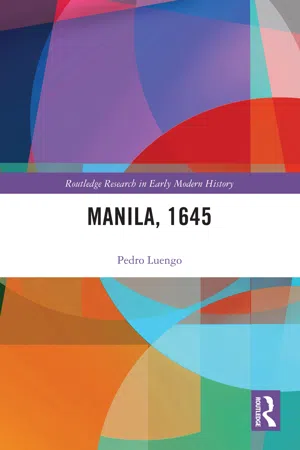Imperial Universalism and Local Self-Awareness
According to Ramón María Serrera, the seventeenth century was a time of consolidation of American self-awareness.8 As he also underlines, European expansion therefore has to be explained from Western, local, and foreign rationales. Although this approach has been broached with regard to Spanish America, it can also be used for the early stages of Western presence in the Philippines, and particularly in Manila. The formation of an identity could be linked to the metropolis, to the vice-regnal capital, to the local, or to other, religious, terms. Apart from these cases, during the initial decades of the seventeenth century, the Iberian Union likewise has to be considered as a more complex situation.9 Many scholars have emphasized that the union between the two empires was never truly achieved. But, at the same time, it is clear that the unfinished union was well accepted in Southeast Asia as a minor problem in the face of the local threat of Dutch expansion, Chinese piracy, and Muslim sultanates. Manila was interested in stressing the sovereignty of the Spanish king over the Portuguese settlement of Macao.10 Indeed, the Philippine governor Gonzalo Ronquillo de Peñalosa sent a diplomatic mission to Macao in 1582.11 Yet, as is made clear in numerous sources, both Portuguese and Spanish societies preferred to maintain their prior independence. Cooperation is perhaps more easily found in more general projects against the Dutch threats.12
8 Ramón María Serrera, La América de los Habsburgo (1517–1700). Seville: Universidad de Sevilla, 2011, pp. 221–236 and 281–292.
9 Kevin Joseph Sheehan, Iberian Asia: The Strategies of Spanish and Portuguese Empire Building, 1540–1700. PhD Dissertation. University of California, 2008.
10 Rafael Valladares, Castilla y Portugal en Asia. 1580–1680: declive imperial y adaptación. Leuven: Leuven University Press, 2001.
11 Manel Ollé, La empresa de China. De la Armada Invencible al Galeón de Manila. Barcelona: El Acantilado, 2002, pp. 95–97.
12 Peter Borschberg, “Ethnicity, Language and Culture in Melaka after the transition from Portuguese to Dutch Rule (seventeenth century)”. Journal of the Malaysian Branch of the Royal Asiatic Society, 83/2, 2010, pp. 93–117.
With regard to the Dutch, the Spanish sources are clear. While the Portuguese are considered as foreigners in some sources, the Dutch are labelled as enemies. In fact, Dutch independence from Spain was not recognized until 1648.13 As a result, the Dutch attacked Manila in 1617, Goa in the 1620s and 1630s, Macao in 1622, and Malacca in 1644.14 In spite of these threats and the decreasing importance of Iberian commerce in the region, the cooperation between Goa and Manila was always difficult politically. Some of the clearest instances of cooperation between Portugal and Spain during this period were in response to Dutch attacks. Andrés Hurtado de Mendoza, who improved the Portuguese fortifications in the Indian Ocean, provides a good example.15 After leaving Goa in 1602, he decided to build a fort in Dachem and another in Sunda. He also visited some of those responsible for other fortifications, such as Esteban Teixeira de Macedo in Amboyne and Francisco da Silva de Menezes in Malacca.
13 Peter Borschberg (ed.), Journal, Memorials and Letters of Cornelis Matelieff de Jonge: Security, Diplomacy and Commerce in 17th-century Southeast Asia. Singapore: NUS Press, 2015, pp. 20–23.
14 Kevin Joseph Sheehan, op. cit., p. 440.
15 Archivo General de Indias (AGI), Filipinas, 35, n. 49, ff. 840r–844r.
This dual perspective on Iberian identity in the region, between cooperation and mistrust, even in the face of Asian or Protestant attacks, made a common self-awareness impossible. Any consideration with regard to Philippine self-awareness during the Iberian Union has to be carried out from the knowledge of the universal aspiration of the Spanish empire.16 While the king was insisting on the image of a global empire, the American and Southeast Asian regions were developing their own distinct features. While America was attempting to demonstrate its role in the empire’s universal image, Manila made very little effort in this sense. It is likely that the continuous renewal of the (New) Spanish population in the city, lacking as it did a permanent local oligarchy, made this even more difficult. On the contrary, the small number of creoles and the local population placed their faith in a hybrid culture, nurtured both from Iberian traditions and from other Asian and American features, from the very start.
16 José Javier Ruiz Ibáñez, “Las percepciones de la monarquía hispánica como un proyecto universal”. Pedro Cardim and Gaetano Sabatini (coord.), António Vieira, Roma e o universalismo das monarquías portuguesa e española. Lisbon: Red Columnaria, 2011, pp. 29–51.
